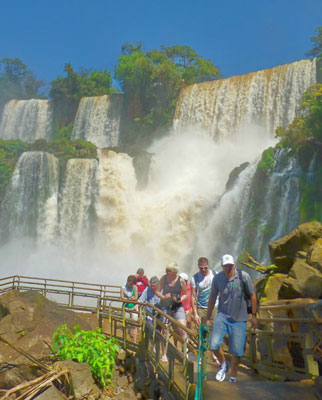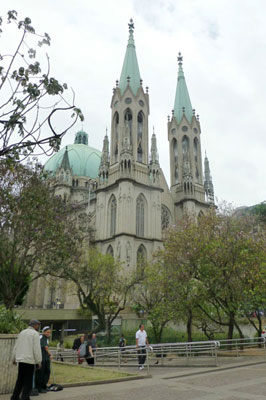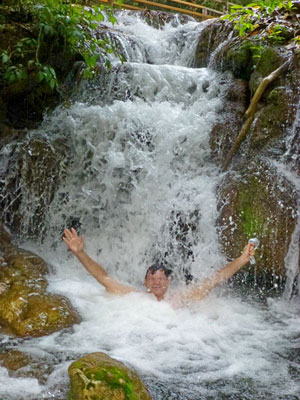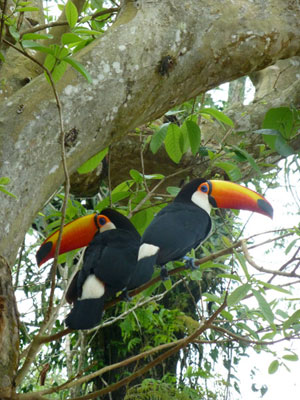Iguaçu Falls, São Paulo and Bonito
This item appears on page 54 of the February 2015 issue.
(2nd of 3 parts on Brazil)
Despite increased access to our ever-shrinking planet, Brazil, the world’s fifth-most-populous country (about 200 million), remains an enigma to even the most seasoned international travelers.
Brazil’s identity is somehow obscured by rampant diversity on fronts ranging from complex ethnicity and a consistently unpredictable, often volatile economy to unparalleled natural world attractions. With a land area comparable to that of the continental United States, Brazil is both a country of teeming, busting-at-the-seams cities and a land where the dedicated explorer can become thoroughly lost in nature.
In this setting, common sense seems to be regularly trumped by nonsense often wrapped in lyrical tones. “Relax. Don’t worry. The sun will still rise tomorrow” seems the standard mantra.
At times, the Brazilian mind-set is maddening, while at other times it seems that perhaps only they truly understand the meaning of life. Either way, in Brazil it’s about the beat, and the beat goes on.
A 3-week exploration
The purpose of my long-awaited first trip to Brazil, Sept. 22-Oct. 11, 2014, was to try to get beneath the surface to gain a true feel for Brazilians and their land. To accomplish this, I chose a comprehensive, 20-day, small-group (16 passengers, maximum) itinerary offered by longtime ITN advertiser ElderTreks (597 Markham St., Toronto, ON, M6G 2L7, Canada; 800/741-7956, www.eldertreks.com).
Including all meals, the land cost for the tour is $8,195 per person, double occupancy, for both the March 2015 and September 2016 departures, both of which are guaranteed. Not included are domestic flights in Brazil (approximately $1,600) and international air, which generally ranges from $1,300 to $1,550, depending on the North American gateway.
My partially hosted journey offered a blend of five distinctly different cities — São Paulo, Brasilia, Salvador, Manaus and Rio de Janeiro — in combination with the amazing nature to be seen at Iguaçu Falls, Bonito, the Pantanal and the Amazon.
Iguaçu Falls
The first stop on our journey in Brazil provided the opportunity for our group of 12 to explore, on foot, both the Argentine and Brazilian sides of spectacular Iguaçu (Iguazú or Iguassu) Falls, among the most impressive falls on the planet.
The falls are situated on the Iguaçu River, on the border of the Brazilian state of Paraná and the Argentinean province of Misiones, dividing the river into the upper and lower Iguazú. Even though it does not seem so when visiting, about 80% of the 2.7-kilometer-wide falls are located on the Argentina side of the border.
The many waterfalls and cataracts range in height from 60 to more than 80 meters, with the number of small waterfalls, depending on water level, ranging from 150 to 300 or more. The amount of water flowing over the falls can change dramatically from day to day, depending on rainfall and other factors.
The single most prominent feature is called the Devil’s Throat, where about half of the river’s flow cascades into a long, narrow chasm.
The falls are a part of the huge, contiguous Iguaçu National Park in Brazil and Iguazú National Park in Argentina and have enjoyed UNESCO World Heritage Site status since 1986. The protection of this South American treasure remains the responsibility of both nations on a cooperative basis.
Despite the crowds of excited visitors, we were able to easily manage our guided walking excursions on the excellent trail systems around the falls. On both sides of the border, the accessibility to a plethora of well-placed observation points separates Iguaçu from most other famous falls I have visited.
On both sides of the border, boats (about $60 per person) are available to transport visitors to the base of the falls — an experience that is not really necessary to gain a full appreciation of the setting.
Iguaçu is on most Brazilian and many Argentinean travel itineraries and is deservedly a popular bucket-list destination for international travelers.
On to São Paulo
It is challenging to comprehend a city metroplex with a population of 20 million that has grown at a breakneck pace since 1928, when there were barely 100,000 residents.
Our full-day tour of bustling São Paulo provided a good introduction. For the most part, we focused our touring on the older part of the city that is generally regarded as Brazil’s financial and cultural capital.
Our guided walking excursion included the hub around Paulista Avenue, the financial center of the city until the 1980s and an area that features impressive examples of Baroque and neoclassical architecture as well as some fine examples of early-modern buildings. Today, São Paulo’s sprawl is so expansive that there are three separate city business centers.
We strolled through the covered Mercado Municipal, with its colorful stained-glass accents and a series of vast domes, where we discovered a thriving market specializing in fresh produce and dry goods, with limitless chances to sample traditional local foods.
We also visited the neo-Gothic-style Catedral da Sé, located on the chaotic main square, the Praça da Sé. Built on the site of a church dating back to 1589, this cathedral is a relatively new structure, completed in 1954 after 42 years of construction.
Visitors should note that walking in the cathedral area requires staying aware of one’s personal security, particularly in regard to cleverly created distractions, as pickpocket specialists abound.
Later, while touring the eclectic, upscale, hilly suburb of Via Magdalena, we marveled at the creative, modernistic-style wall murals along now-famous Batman’s Alley. This was our first experience with the street art phenomenon that has become so popular in many Brazilian cities.
In truth, visitors to São Paulo could be busy for days investigating the many interesting cultural attractions of the city.
Bonito escape
After flying from São Paulo to Campo Grande, our cross-country drive to Bonito showcased the endless farms and ranches of wide-open, flat cattle country. This relaxing introduction offered a welcome respite from the throngs of humanity that defined our first four days in Brazil.
We were bound for the ecological oasis of Bonito, located in the Bodoquena Mountains, at the edge of Brazil’s renowned Pantanal in the southwestern state of Mato Grosso do Sul.
Our first morning in Bonito, we visited the Gruta do Lago Azul (Blue Lagoon Grotto). Three hundred meters and 287 steps down from the cave’s entrance is a lake of deep-blue water, whose origin is unknown, since the water is a different color than the clear greenish tone of the rivers and streams in the area.
Later we ventured to Estância Mimosa, a private farm oasis where a 2.3-mile trail along a pristine stream reveals seven separate sets of beautiful waterfalls, each with its own idyllic swimming hole.
After a bountiful lunch featuring produce cooked on an open wood-fire stove, we walked the streamside forest trail, stopping on our return to swim at three of the best waterfall swimming holes. Mimosa was absolutely a swimmer’s paradise, one including complimentary “massages” for those of us who ventured into and under the pounding falls.
In this expertly managed private reserve, the numbers in walking groups are controlled and the groups are well staggered, assuring visitors a serene experience walking and swimming in the forest.
More Bonito treasures
The next morning we departed for pristine Rio Sucuri, where most of our group donned required wetsuits and life jackets for a magical, 1.6-kilometer, gentle drift downstream. The mostly shallow waters offered unlimited underwater visibility, revealing a wealth of colorful fish and other riverine life. Completely safe and requiring minimal swimming skills, the float was a trip highlight for many.
In the hot afternoon sun, we embarked on a guided walk around Buraco das Araras (Hole of the Macaws), a 72-acre private reserve and sanctuary featuring South America’s largest sinkhole.
The rock walls around the 100-meter-deep, 500-meters-across pit are home to flocks of beautiful tricolored (red, blue and green) macaws. Their colors were intoxicatingly appealing and their squawking calls, in amplified surround-sound stereo, most unique.
A blue-green lagoon at the bottom of the pit is surrounded by lush vegetation, forming a unique mini-ecosystem with an abundance of wildlife. From two prime vantage points on the rim, we were able to get an intimate exposure to the life of these fantastic birds, and I was able to score amazing macaw photos utilizing my telephoto lens.
In the afternoon we pointed our rig west for the lengthy drive to the Pantanal, the final leg of which would be off the bitumen in the darkness.
Next month I’ll describe our explorations in the Pantanal, an astounding wildlife paradise, followed by the capital city of Brasilia and colorful, exciting Salvador.
CLARIFICATION — In part two of the article about my June 23-29, 2014, trip to Japan (Dec. ’14, pg. 62), I listed room-only rates for the ryokan Nishimuraya Shogetsutei (www.nishimuraya.ne.jp/shogetsu/en), located in Kinosaki in the Kansai region. These rates were available through Japan hotel booking sites.
Generally, for this property, daily rates are on a per-person basis, include dinner, breakfast and taxes and run $215-$356 in a standard room and $233-$403, superior. There are multiple room types in each category. Check the hotel’s website and other booking sources for specials. — Randy Keck
Contact Randy at 80 America Way, Jamestown, RI 02835; 401/560-0350, randykeck@yahoo.com.




